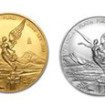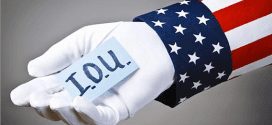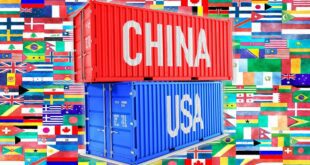A true solution to both fiat currencies and the shock of their demise exists right now, if only the leaders of the world’s nations were able to recognize it. [Believe it or not, it’s the Mexican Libertad. Let me explain its design and usage and how it could easily become the foundation of a new non-fiat international currency.]
if only the leaders of the world’s nations were able to recognize it. [Believe it or not, it’s the Mexican Libertad. Let me explain its design and usage and how it could easily become the foundation of a new non-fiat international currency.]
The above introductory comments are edited excerpts from an article* by Jeff Thomas (internationalman.com) entitled The Mexican Libertad: The Currency Solution?.
Thomas goes on to say in further edited excerpts:
The End of Fiat Currency
In the past one hundred years, more than twenty fiat currencies have collapsed due to hyperinflation.
- In 1993 in Yugoslavia, when the dinar collapsed, the German deutschemark became the unofficial currency by default, as it was the nearest reliable currency.
- In 2008 in Zimbabwe, when the Zim dollar collapsed, the U.S. dollar became the unofficial currency, as it was the most readily available alternate currency.
What happens when all or most of the world’s principal currencies fall together? What happens when the very system of fiat currency fails, as appears likely?
These 21 Countries Have Experienced Hyperinflation In the Last 25 Years
There can be no question that, the very next day, commerce would need to continue. People would need to buy groceries and gasoline. As they have done historically, people would turn to whatever alternate form of currency they most trust. With the sudden loss of most or all fiat currencies, the logical choice would be gold and silver—the currencies that mankind has returned to time and time again for 5,000 years. Even though that may be the logical solution, there would be that problem of denomination…unless a system existed in each country to provide an official value to a specific weight of precious metal on a daily basis…
The Mexican Libertades
[This brings us to]…the true beauty of the Mexican Libertad. The Libertad was first issued in 1981 in .999 fine gold and then in silver in 1982. Beginning in 1991, the Libertades became the only coins in the world that were issued in the convenient sizes of 1/20, 1/10, 1/4, 1/2, and 1 ounce—again, in both gold and silver and, unlike most gold and silver coinage in the world, do not show face values; it shows only a weight. It can therefore change in value daily. The coins are put into circulation as legal tender with a floating value that is quoted daily by the Banco de México. The coins can additionally be exchanged for paper pesos at certain Mexican banks. [Given the above, the Libertads have the ability to completely eliminate any problem that would be caused should the Mexican peso crash. As long as there were sufficient coins in circulation, the shock from the fiat currency collapse would be circumvented, and the next day, it would be business as usual. (and this would be true for larger purchases if, in addition to the silver Libertad, a gold Libertad were in circulation.)Although the decision to issue the Libertad in this fashion is a simple one, in terms of importance, it has the potential to be monumental. In a world in which all countries presently operate on a fiat money system—a system that in the not-too-distant future may well collapse—the Libertad could be a true monetary solution.
Not surprisingly, at present, no government in the world is hinting publicly that its currency may fail. Hopefully, though, they are aware that collapse may be on the way in the not-too-distant future. If not, as the time gets closer, more and more political leaders will, no doubt, accept the possibility. With the Libertad already successfully in place in Mexico, it would not be surprising if, one by one, other countries pick up the idea. If so, the first to do so will be those countries that are smaller and less powerful—the ones that suffer the most when larger countries fail.
If this were to happen—if other countries were to create their own version of the Libertad, in the same standard weights and with no face value—the next development would be the most significant one, as regards international commerce.
The Libertad as an International Currency
Were many countries other than Mexico…to institute a similar coinage system, the Libertad would essentially be interchangeable with his other such government coinage. The only difference would be the name of the country on the coin.
If, say, a dozen countries were to implement similar coinage systems prior to the actual occurrence of worldwide fiat currency collapse, the concept of gold and silver as reliable international currency would already have established itself in the minds of merchants and consumers alike. In essence, it would be the obvious solution, even to those leaders who very well may not have been astute enough to figure it out on their own.
It would not take long for the average till to contain a mix of coins, all from different countries. (Although this concept may, today, seem unlikely to be acceptable, I believe it would catch on fairly quickly. When I was a boy, the local currency was pegged to the U.S. dollar, which meant that every till had local and U.S. dollar bills mixed together interchangeably. No one gave it a second thought.)
Certainly, we shall soon experience a series of shocks, if fiat currencies bite the dust. This, ultimately, will be a very good thing, as the fiat currency concept is a very bad idea and, certainly, other currencies of one type or another will surface quickly, out of sheer necessity. Some countries may try to float new fiat currencies; some may attempt electronic currency but each of these choices would be a return to the same old problem.
A true solution to both fiat currencies and the shock of their demise exists right now, if the leaders of the world’s nations are only able to recognize it…
Editor’s Note: The author’s views and conclusions in the above article are unaltered and no personal comments have been included to maintain the integrity of the original post. Furthermore, the views, conclusions and any recommendations offered in this article are not to be construed as an endorsement of such by the editor.
*http://www.internationalman.com/articles/the-mexican-libertad-the-currency-solution (Copyright © 2014 Casey Research, LLC.)
If you liked this article then “Follow the munKNEE” & get each new post via
- Our Newsletter (sample here)
- Twitter (#munknee)
Related Articles:
1. Here’s a Dirty Little Secret About Cleaning Bullion Coins
Improper cleaning results in the loss of a small amount of metal from the surface of the coin. Repeated cleaning can actually lower the grade of a coin by removing too much metal. To learn the answer as to what is the best way to go about storing and cleaning your gold and silver coins read on. Words: 417 Read More »
2. Beware The Dangers In Buying Certain Gold Coins – Here’s Why
At first glance, buying gold may seem a simple, straight forward process. However, there are dangers, such as falling for a telemarketer’s line that his coins are “non-confiscatable” and somehow have more value because you bought them from him. Basic bullion is the way to go when investing in gold. Words: 788 Read More »
3. The History of Money – From Gold & Silver to Fiat Currencies
Today’s monetary system, combined with fractional reserve banking, has a lot of risks. It is vulnerable to bank runs, inflation, and economic bubbles, to name just a few, yet those risks remain invisible to the majority of people. This article provides links to a video and an extended report that provide insights into the question as to why today’s paper based money system is doomed to fail and how you can protect against such a collapse. Read More »
4. Physical Gold Cannot Possibly Lose Out Over Fiat & Digital Currencies – Here’s Why
Gold cannot possibly lose its central position as the pre-eminent money used by the world for thousands of years. The aggressive measures of the Anglo-American Axis with regard to gold are absurd and they will lead to total disaster both for the Axis, and for the world which has been forced to follow its lead for over forty years. Read More »
5. James Turk: Why Gold is Preferred to National Currencies
Some say that the gold price rises and falls, but they are grabbing the wrong end of the stick. It is the purchasing power of national currencies that rise and fall. Here is an analogy to make this point clear. When standing in a boat and looking at the shore, it is the boat (currencies) – and not the land (gold) – that is bobbing up and down. [Let me explain the value of gold further.] Words: 631 Read More »
6. These 21 Countries Have Experienced Hyperinflation In the Last 25 Years
Hyperinflation is not an unusual phenomenon. 32 countries have experienced hyperinflation over the last 100 years of which no less than 21 have experienced it in the past 25 years and 3 in the past 10 years. The United States is one of the few countries to have experienced two currency collapses during its history (1812-1814 and 1861-1865). Could it happen again? Words: 1450 Read More »
 munKNEE.com Your Key to Making Money
munKNEE.com Your Key to Making Money


